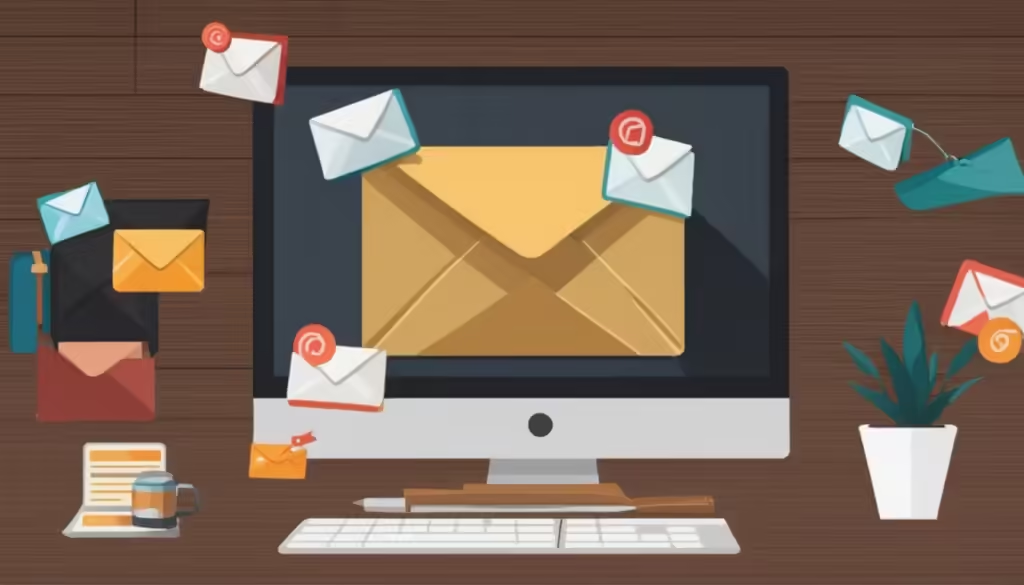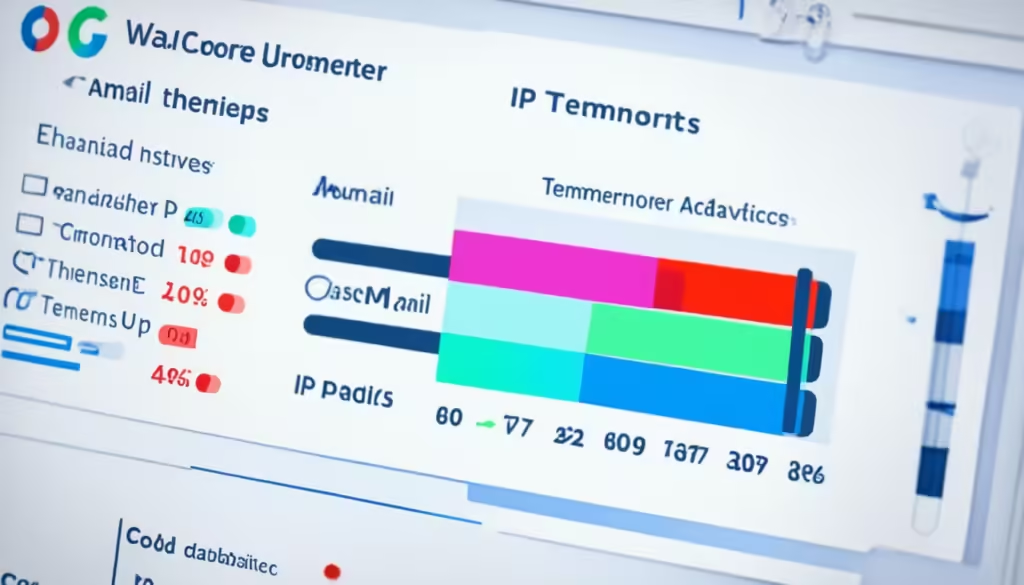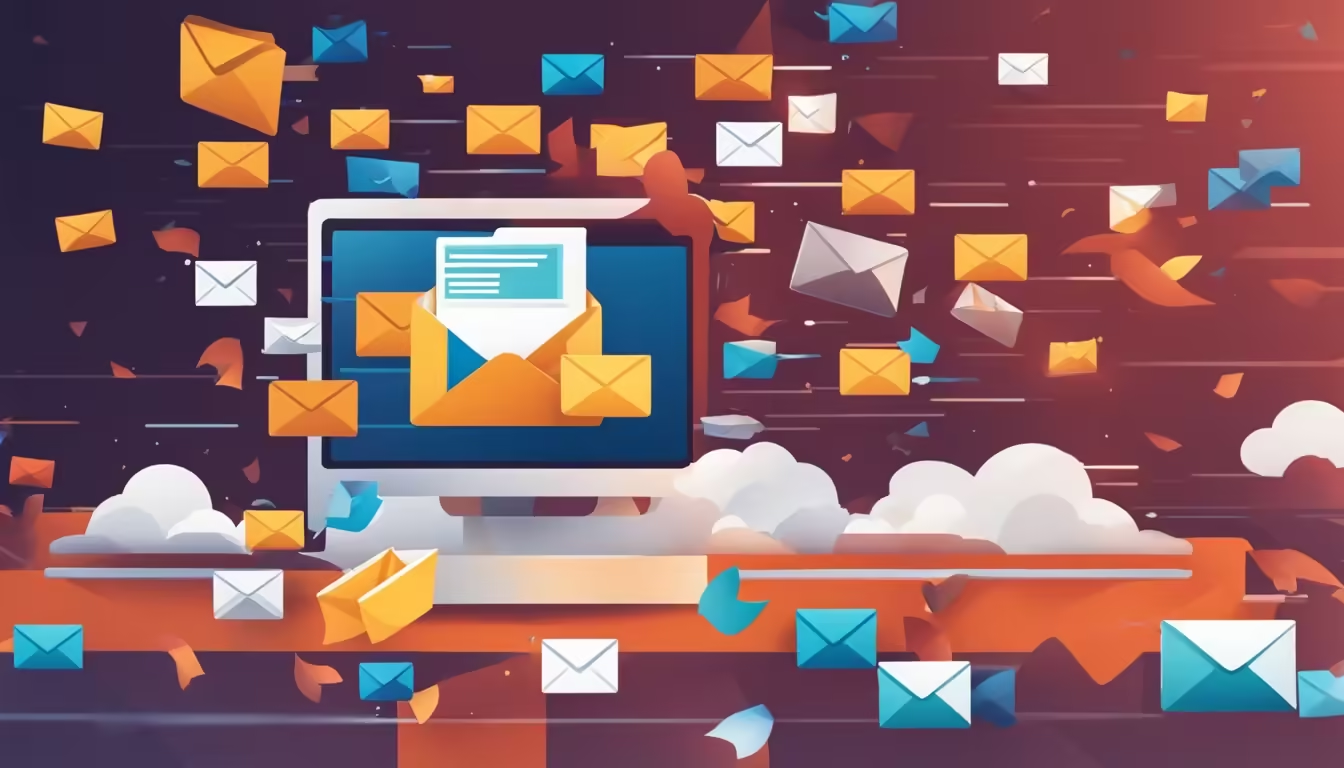Being an email marketer means I focus on making emails that catch the eye. I work on the content, the look, and the subject line to make you want to open them. But, the biggest challenge is making sure these emails get to the right place. Many of us struggle with this, even though we know how to make our emails more likely to land in the inbox.
In this piece, I will explain what email deliverability means. I will talk about why it’s different from email delivery and why it’s so important. We’ll dive into what affects it and share tips on making sure your emails end up in the right inboxes.

Key Takeaways
- A decent Email deliverability rate is crucial to ensure that emails are reaching subscriber inboxes.
- Around 25,000 daily emails might be the threshold where a switch to a dedicated IP address for sending becomes necessary to maintain proper email infrastructure.
- Using double opt-in processes can significantly help in cultivating an engaged email list.
- Monitoring and cleaning up email lists regularly can help maintain a healthy email list, avoiding damage to reputation and deliverability rates.
- Pleasing recipients with valuable email content also plays a crucial role in improving email deliverability, as happy recipients lead to better engagement and higher chances of emails being placed in the inbox.
Understanding Email Deliverability
Email deliverability means how often your emails get into people’s inboxes. If more of your emails end up in spam or bounce back, your deliverability is low. It reflects on both the number of emails that make it and where they go in the inbox. Problems with getting your emails delivered can be due to old methods, sending without permission, or too many spam reports. Good deliverability is key to making money from your emails. Emails stuck in spam or promos are not likely to be opened.
What is Email Deliverability?
Email deliverability is making sure your emails land where they’re meant to. It’s super important for your email marketing to work well. If deliverability is low, your messages might not reach many people.
Email Delivery vs. Email Deliverability
Email delivery and deliverability are similar but not the same. Delivery is about getting emails to recipients, no matter the inbox they land in. Deliverability focuses on the emails that hit the main inbox. Even with a high delivery rate, open rates may still be low. This shows that not just sending, but how your emails are received matters too.
Why Email Deliverability Matters
Good email deliverability is vital for your marketing success. Stats show around 20% of legal emails don’t make it to the inbox. Keeping your deliverability high makes sure your audience sees your messages. This boosts interaction and results in better returns on your email marketing. Watching metrics like bounces and opens gives you clues on how engaging your emails are. These insights help you maintain a good email reputation.
Factors Affecting Email Deliverability
To make your email marketing work, a good deliverability rate is key. Many things can influence this, like your reputation, the emails themselves, how you send them, and if you send a lot at once.
Sender Reputation
Your sender reputation matters the most for getting emails in inboxes. What users do with your emails, such as unsubscribing or marking them as spam, impacts this. So does how much they engage with your content. You should send emails that people want to open and interact with. This will help keep your reputation high and make sure your emails are seen.
Email Content
Email content quality and relevance matter a lot. The subject line, format, and words you use can affect how emails are perceived. The goal is to avoid things that make emails look like spam, such as all-caps or too much punctuation. And don’t use misleading subject lines.
Email Infrastructure
How you send emails is also crucial. Your mail servers and IP addresses need to be in good shape. It’s important to show email providers you’re legitimate by using a dedicated IP and correctly setting up things like SPF and DKIM.
Email Volume Spikes
Too many emails sent too quickly can be a problem. It’s best to increase sending carefully to avoid looking like a spammer. This steady approach is better than suddenly bombarding people.

By taking care of these aspects, you can make sure more of your emails end up where they should. This drives better engagement and results from your email campaigns.
Authenticate Your Email Domain
Authenticating your email domain is key for better email delivery and to stop spoofing. Use techniques like SPF, DKIM, and DMARC to tell ISPs you’re the real sender. This makes sure your emails get through.
Sender Policy Framework (SPF)
SPF checks if incoming emails are really from who they say. It looks at where the email came from to stop fake emails. This way, servers can confirm it’s really from your allowed addresses.
DomainKeys Identified Mail (DKIM)
With DKIM, emails get a hidden signature that ties them to your domain. This stops anyone from changing your email. It makes sure your message stays secure and intact.
Using DKIM makes your emails look more professional and helps them get delivered better.
Domain-based Message Authentication, Reporting & Conformance (DMARC)
DMARC is like a combo of SPF and DKIM to fully secure your emails. It tells servers how to treat your messages, cutting out fakes and getting your real ones in. Doing DMARC means big email services like Google and Yahoo are more likely to take your emails in.
Using these email safety steps helps ISPs trust you more and keeps your emails from being counterfeited. This boosts how well your email marketing works.

Warm Up Your IP Address
As your email program gets bigger, a dedicated IP address keeps your emails on track. But, to avoid email problems, warm up that new IP first.
Contact your email service provider to help you smoothly warm up your IP.
This warm-up includes sending more emails over time. You start slowly, then go up to sending a lot more after about 35 days. Making a good name for yourself when starting fresh is better than fixing a bad reputation later on.
SendGrid advises users to follow a warming-up plan. Doing this helps keep your email reputation in tip-top shape.
For IP warming, increase your email sending bit by bit every day for roughly 15 to 60 days. In the first 15 days, double your email sent each day. Good email providers have tools to help this process flow smoothly.
Use emails like purchase receipts and account alerts to warm up your IP. These kinds of emails are opened more often, which helps build a good reputation right from the start. Special API tools can automatically adjust email sending speeds based on your warm-up plan. While these transactional emails don’t need a strict plan, it’s smart to slowly ramp up marketing emails for better long-term results.
To stay on top of your email game, keep an eye on how things are going with tools like MXToolbox and 250ok. Services notice your emails once you hit about 100 per day.

Perfect the Opt-in Process
Creating a top-notch email list is key to good email deliverability. How you gather email addresses matters a lot. It affects whether your emails make it to the inbox. Opting for a double opt-in or confirmed opt-in method means your list will include people who are truly interested in your emails. This approach stops you from messaging uninterested folks. They might see your emails as spam, leading to a lower sender reputation.
Having a simple and clear way for people to sign up or leave builds trust. It signals honesty to both subscribers and Internet Service Providers (ISPs). With a double opt-in, users confirm they want to join by clicking a link in an email. This not only boosts your deliverability but also keeps your email list lively and engaged.
Optimize Subject Lines
Email subject lines are vital for reaching your audience. Crafting the right ones is key for better[email subject line optimization] results. It’s best to avoid common[spam trigger words], all caps, and too many punctuation marks. This helps your email steer clear of spam folders. Instead, create subject lines that are engaging and valuable, not pushy or purely sales-oriented.
The perfect email subject line isn’t too long. Research points to around41 characters, which is about 7 words. This length tends to grab more attention. The ideal length is under 60 characters or about 6-8 words. For compatibility across devices, keep in mind that Gmail can show up to 70 characters before cutting off the rest.
Personalized subject lines, including the reader’s name, often do better. They can boost how many people actually open your message. Subject lines with special offers, such as discounts, can also have a positive effect on open rates.
Using humor or emojis and employing time-sensitive language can be clever. But remember, they must be applied carefully to avoid spam filters. Words like ‘urgent’ grab attention, as do subject lines that spark curiosity or hint at something special inside.
Don’t forget to test your subject lines on various devices. This ensures they look good and make sense to everyone. A/B testing and Multivariate testing can also guide you to the best strategies.
email deliverability Best Practices
To keep your emails reaching inboxes, it’s vital to trim and reach out wisely. This means making sure your email lists are clean and your readers find value in what you send. Remember, ISPs watch closely how often you’re flagged as spam, what you send, and the tech you use to send it. All these factors play a big part in your emails getting through.
Provide a Preference Center
A preference center gives people the power to choose what emails they get and when. It’s a great way to show you care about what they want to see, and that can lower the risk of your emails being reported as spam. Plus, it helps people get the emails they want, how they want them. All of this leads to happier readers and better engagement.
Maintain Clean Email Lists
Regular housekeeping of your email lists is key. Purging inactive readers prevents your emails from heading to the spam folder. This also keeps your sender score high, meaning more of your emails will reach readers who are interested. Keeping your lists fresh is vital to sending emails that stick in inboxes.
Avoid Spam Traps
Falling into spam traps can be a big problem. These traps hide among email lists to catch those who aren’t careful. Hitting these traps can hit your sender’s score hard, making your emails less likely to get delivered. So, be sharp about cleaning your lists to dodge these traps. It’s a crucial step in making sure your emails are reaching real people.
Send Engaging Emails
Creating emails that people want to open is a must. This means your content has to be interesting and helpful. Putting real value in your emails not only boosts open and click-through rates but keeps them out of the spam folder. This way, your emails stand a better chance to make it right to your reader’s inbox.
Monitor and Improve
It’s key to keep an eye on how well emails reach folks. This means always checking things out. Tools like Google Postmaster can help by showing your sender rep. Looking at details, like bounce rates and how folks react to your emails, is smart. It helps figure out what’s wrong and fix it. If you fix things fast, your emails will keep landing in the inbox.
Check Sender Reputation and Blacklists
Keeping your sending status high and out of blacklists is a must. Use Google Postmaster and blacklist checkers to check often. This makes sure your address isn’t marked as spam. Only then can your emails go through smoothly.
Analyze Performance Metrics
Studying email stats like bounce rates and how many people mark you as spam can show problems. Understanding these numbers is crucial. It guides you to change your tactics for better inbox success over time.
Conclusion
Getting your emails to the right place is key for email marketing to succeed. Know how your sending reputation, email content, and email setup affect delivery. Use SPF, DKIM, and DMARC, start slow with your IP, and make it easy to opt in. This way, more of your emails will make it to the people you’re trying to reach. This boosts how much people interact with your emails and your overall success.
Keep an eye on how your emails perform and adjust based on what the data tells you. By doing this, you can keep your email delivery strong over time. Making email deliverability a top priority helps you use email marketing to its fullest. This leads to better outcomes for your business.
To do your best, make sure your email list is up to date. Also, send out interesting content. Tools like GMass can help you check and improve your email delivery success. It’s important to understand what affects email delivery, such as list quality and your reputation. This lets you smartly adjust your email strategy.
By following these steps, and keeping an eye on your emails’ performance, you ensure they get seen more. This can increase how many emails are opened and clicked. Making sure your emails get delivered is the first step in email marketing success. By focusing on this, email can become a powerful tool for you.
FAQ
What is email deliverability?
Email deliverability is how often your emails land in inboxes. If emails bounce or go to spam, the rate is low.
What is the difference between email delivery and email deliverability?
Email delivery counts all emails that are sent and reached someone. Deliverability looks at those that made it to the main inbox.
Why does email deliverability matter?
It matters because low rates can mean fewer opens and clicks. This, in turn, could hurt your email marketing’s success. People often don’t check spam or promo folders.
What factors affect email deliverability rates?
Things like your reputation, the email’s content, your setup, and sudden spikes in emails matter. What people do with your emails, such as marking them as spam, affects your reputation the most.
How can I authenticate my email domain?
By using SPF, DKIM, and DMARC, ISPs know your emails are safe. This reduces the chances of your emails being spoofed and helps your delivery rates.
How do I warm up a new IP address?
Start by sending emails slowly, then increase to more volume. This shows ISPs you’re genuine before hitting bigger volumes.
What is the importance of the opt-in process?
A double opt-in makes sure your subscribers really want your emails. It avoids sending to those who could spam-flag your emails.
How can I optimize email subject lines?
Stay away from spam words, caps lock, and too many symbols. Create subject lines that draw people in naturally without being pushy.
What other email deliverability best practices should I follow?
Offer a preference center and keep your lists clean. Also, avoid traps, and make your content engaging and valuable.
How can I monitor and improve my email deliverability?
Keep tabs on your reputation and important metrics like bounces and complaints. Fix any issues fast to maintain good deliverability.
Source Links
- https://sendgrid.com/en-us/blog/8-best-practices-to-improve-your-email-deliverability
- https://www.campaignmonitor.com/resources/glossary/email-deliverability/
- https://www.activecampaign.com/glossary/email-deliverability
- https://mailtrap.io/blog/email-deliverability/
- https://www.litmus.com/blog/why-email-deliverability-matters
- https://clearout.io/blog/factors-that-impact-email-deliverability/
- https://www.campaignmonitor.com/blog/email-marketing/9-things-that-are-killing-your-email-deliverability/
- https://mailchimp.com/help/about-email-authentication/
- https://sendgrid.com/en-us/blog/how-to-authenticate-your-email-in-5-steps
- https://www.rejoiner.com/resources/how-to-warm-up-a-new-ip-address
- https://www.twilio.com/docs/sendgrid/ui/sending-email/warming-up-an-ip-address
- https://optinmonster.com/email-deliverability-best-practices/
- https://www.campaignmonitor.com/blog/email-marketing/best-email-subject-line-length/
- https://verticalresponse.com/blog/unlocking-secrets-powerful-email-subject-lines/
- https://mailchimp.com/help/best-practices-for-email-subject-lines/
- https://blog.hubspot.com/blog/tabid/6307/bid/30594/a-marketer-s-guide-to-getting-past-email-spam-filters.aspx
- https://www.sendpost.io/blog/email-deliverability-tools
- https://folderly.com/blog/email-deliverability-monitoring
- https://www.gmass.co/blog/what-is-email-deliverability/
- https://www.customerly.io/glossary/email-deliverability/
- https://dmarcreport.com/blog/why-is-email-deliverability-important-for-online-businesses/

